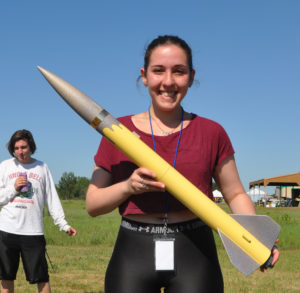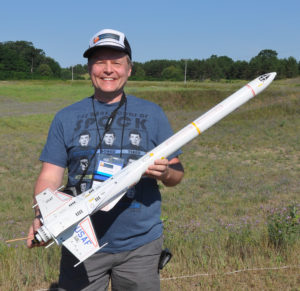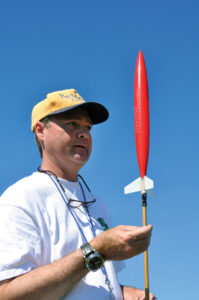Flying in Your First Meet
 by Jeff Vincent, NAR 27910
by Jeff Vincent, NAR 27910
No doubt some of you out there have read the competition reports written here and elsewhere and have become somewhat curious as to just what this competition business is all about. Well, the best way to learn is by doing, and this article is your guide to entering competition.
Rule number one: there is no reason to feel intimidated by competition. For some reason, some people are insecure and are afraid that they will embarrass themselves if they compete. Don’t worry about this. No one expects you to do everything right your first time out, as all of us have had some rough starts. In fact, as you continue to fly, you will find a good many pros who have a tough time of getting it right every time.
As far as requirements go, the only prerequisite is membership in the National Association of Rocketry (NAR), as all of our meets are sanctioned by this group. Your one year membership allows you to fly in NAR competition and entitles you to benefits such as manufacturer discounts, the Sport Rocketry magazine, and The Electronic Rocketeer newsletter. While not required, many fliers are also members of their local NAR section (or club). Membership in your local section helps to support rocketry in your area and puts you in touch with other modelers in your area. Sections members hold workshops, conduct meets, travel to other rocketry events, and publish newsletters.
 Now that you have decided to fly and you’ve applied for your NAR membership, what’s next? The first step is to learn the rules. Start by reading the Basics of the Rules section. For the full rules, consult the NAR U.S. Model Rocket Sporting Code, better known as the “Pink Book” for its traditional cover color. (Due to cost constraints, the NAR provides this document only online.) The Pink Book contains all the rules for flying competition. It can look rather imposing at first, although with some explanations from more experienced fliers, you should pick it up. Although you probably can get by without reading it, knowing the Pink Book is like any rule book: you are less likely to get burned if you know all the rules.
Now that you have decided to fly and you’ve applied for your NAR membership, what’s next? The first step is to learn the rules. Start by reading the Basics of the Rules section. For the full rules, consult the NAR U.S. Model Rocket Sporting Code, better known as the “Pink Book” for its traditional cover color. (Due to cost constraints, the NAR provides this document only online.) The Pink Book contains all the rules for flying competition. It can look rather imposing at first, although with some explanations from more experienced fliers, you should pick it up. Although you probably can get by without reading it, knowing the Pink Book is like any rule book: you are less likely to get burned if you know all the rules.
Once you have studied the rules, look for a meet in the “Launch Windows” section of the NAR website. (Just to explain some of the terminology, a “meet” is our word for a contest; at each meet there are usually three to six distinct “events”.) Here you can find the dates, locations, events, and contacts for meets in your area. Once you find a specific meet, you can begin planning how you want to fly it. There is no requirement as to how many of the events you must enter, although by flying more events you can earn more contest points. You might select only one or two events to try out at first or you may decide to try your hand at all of them, it’s up to you. You should figure out what you need to fly the meet: what rockets you will have to build, what parts and engines will you need? Articles and plans on this website and looking at other flier’s models should give you some ideas as to just what you plan to build. Start working on your models soon, it’s amazing just how quickly that meet date will creep up on you! Planning ahead also allows you to test fly your models to see if they will work as you intend them to. This will give you a chance to fix them before the meet, instead of “DQing”.
 Now it’s the night before the meet, and time to get everything together. (If I only had one more week!!!) It’s a good idea to make a list of the models, engines, recovery systems, etc. that you intend to bring along to the meet. This will make it easy to make sure you won’t forget anything. Most meets provide a launch system for you to fly, although you may want to bring along some custom launch pad for your use.
Now it’s the night before the meet, and time to get everything together. (If I only had one more week!!!) It’s a good idea to make a list of the models, engines, recovery systems, etc. that you intend to bring along to the meet. This will make it easy to make sure you won’t forget anything. Most meets provide a launch system for you to fly, although you may want to bring along some custom launch pad for your use.
When you arrive at the meet go over to the range to check-in. You will be asked to show your NAR license — so don’t forget to bring it! — fill out an entry blank (known as a CB-1-70), and perhaps pay a nominal fee to cover expenses and awards. If you are under 21 your entry blank must be signed by a parent or guardian, so if your parents aren’t coming be sure to take care of this ahead of time. You will then get a set of flight cards. You must fill in your name, NAR number, division (A,B,C,Team), and the event you are flying, one event per card. (Make sure you fill in the “Duration” side for duration events and the “Altitude” side for altitude events!)
Now you can begin prepping your first flight. Get your model ready to go, making sure that the engine type is visible on the label. This must be checked when you fly, so make sure it’s visible. (When using mini engines, it helps to select engines with the labels near the nozzle.) Reloadables must be checked prior to assembling the motor, so consult with the range officials. Take your model and the proper flight card back to the range table. The Range Safety Officer (RSO) will check the engine classification, assess the model’s safety, and assign you a launch pad. You can go to the pad and set up your model. Once you are ready to fly, signal the Range Control Officer (RCO, usually the same as the RSO at small meets). The RCO will alert whatever personnel — timers, trackers, or judges — are necessary to judge the flight, give a five second countdown, and launch the model. The model will be timed or tracked (or judged) and you can run out to recover it. If the flight does not conform to the rules, the judges may DQ it or request that it be returned to check if it performed properly. If the rocket must be returned, either by judge’s request or because the event requires it, bring it back to the range table in flight condition within a reasonable length of time. This means don’t remove the engine, recovery device, or payload!
With you first flight under your belt, you can now make the rest of your flights. Although you will find your time will be pretty full, there are other things to do. While precedence is given to contest flights, most meets allow non-contest flights so you may want to fly some sport models. There is usually a need for timers, so you may wish to volunteer for this duty. Timing models is one of the best ways to learn about competition. It gives you a good look at what works and what doesn’t in each event and should give you lots of ideas for the next time you fly. You can also learn a lot and have a lot of fun talking with your fellow competitors. While it’s not always the best idea to begin a conversation when someone is wrapped up in prepping their model, most people are more than willing to talk about their models and share techniques.
Well, that just about covers your first meet. At the end of the meet, or in a week or so, you will receive the results and see just how you fared (and how many ribbons you won!). However, you get more than ribbons from flying a meet. The true essence of competition is the experience of testing your skills while learning more and having fun along the way. There’s the experience of sharing the day with other rocketeers. While rocketry is sometimes a solitary sport, model rocket meets are an opportunity for rocketeers to get together and enjoy their hobby together. This is perhaps the best reason to join in competition. See you out there!